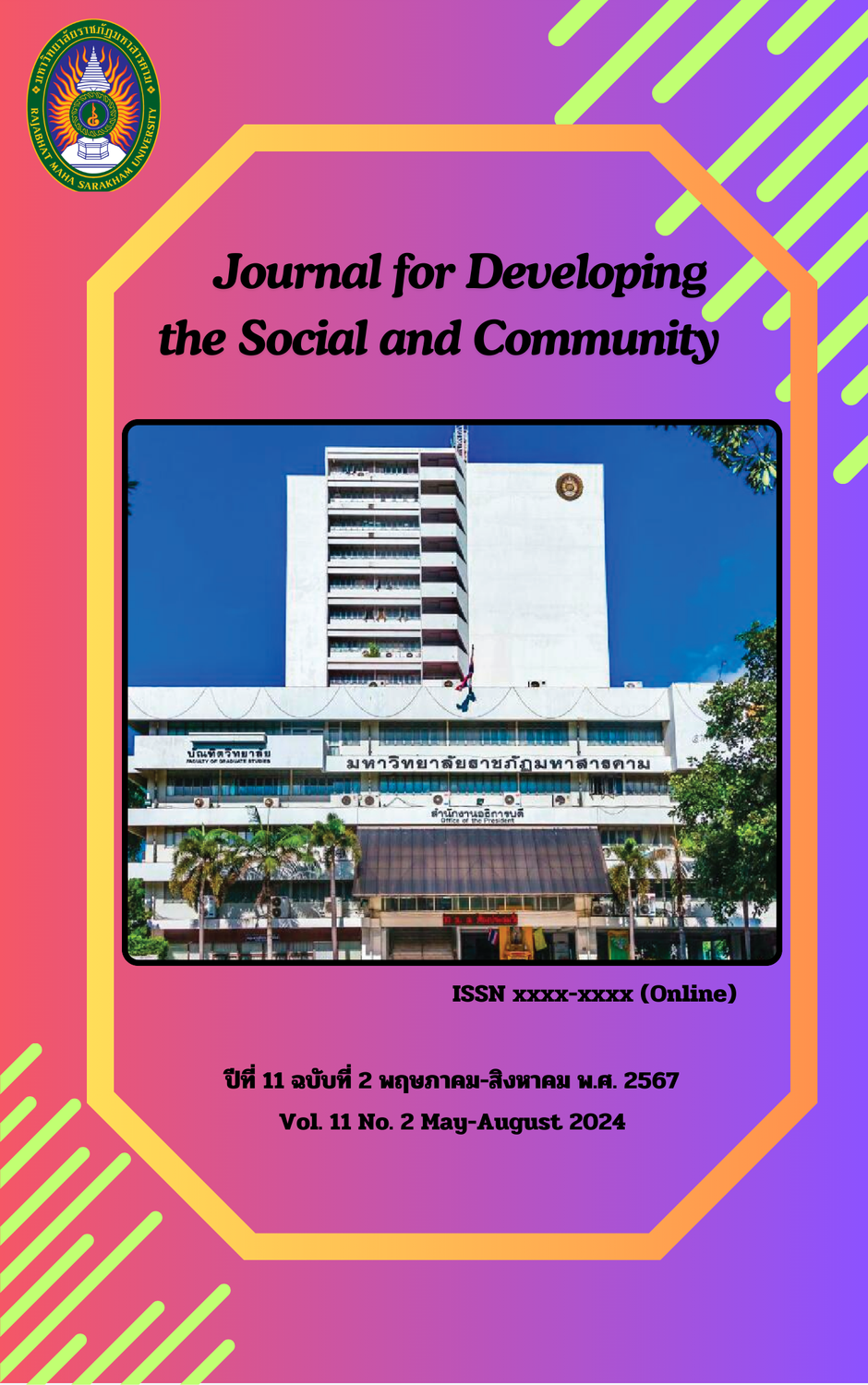การศึกษาการแสดงแทนกับการแก้ปัญหาทางคณิตศาสตร์ ของนักเรียนชั้นมัธยมศึกษาปีที่ 1
คำสำคัญ:
การแสดงแทน, การแก้ปัญหาทางคณิตศาสตร์บทคัดย่อ
การวิจัยครั้งนี้มีจุดประสงค์เพื่อ (1) ศึกษาการแสดงแทนของนักเรียนชั้นมัธยมศึกษาปีที่ 1 (2) ศึกษาการแก้ปัญหาทางคณิตศาสตร์ของนักเรียนชั้นมัธยมศึกษาปีที่ 1 (3) ศึกษาความสัมพันธ์ระหว่างการแสดงแทนกับการแก้ปัญหาทางคณิตศาสตร์ของนักเรียนชั้นมัธยมศึกษาปีที่ 1 กลุ่มเป้าหมายที่ใช้ในการวิจัยครั้งนี้ คือ นักเรียนชั้นมัธยมศึกษาปีที่ 1 โรงเรียนสารคามพิทยาคม ตำบลตลาด อำเภอเมืองมหาสารคาม จังหวัดมหาสารคาม สังกัดสำนักงานเขตพื้นที่มัธยมศึกษาเขต 26 จำนวน 2 ห้องเรียน รวมทั้งหมด 80 คน ห้องที่ 1 นักเรียนชั้นมัธยมศึกษาปีที่ 1/6 จำนวน 40 คน ห้องที่ 2 นักเรียนชั้นมัธยมศึกษาปีที่ 1/8 จำนวน 40 คน ซึ่งได้โดยการเลือกแบบเจาะจง (Purposive Sampling) เครื่องมือที่ใช้ในการวิจัยได้แก่ แบบทดสอบการแสดงแทน แบบทดสอบการแก้ปัญหาทางคณิตศาสตร์ และแบบสัมภาษณ์กึ่งโครงสร้างเกี่ยวกับการแสดงแทนกับการแก้ปัญหาทางคณิตศาสตร์ สถิติที่ใช้ในการวิเคราะห์ข้อมูล ได้แก่ ร้อยละ ค่าเฉลี่ย ส่วนเบี่ยงเบนมาตรฐาน การหาสัมประสิทธิ์สหสัมพันธ์ของเพียร์สัน และใช้วิธีการศึกษาเฉพาะรายกรณี (Case Study Method) โดยนำเสนอข้อมูลด้วย วิธีพรรณนาวิเคราะห์ (Descriptive Analysis) ผลการวิจัย พบว่า (1) ระดับการแสดงแทนของนักเรียนชั้นมัธยมศึกษาปีที่ 1 ส่วนใหญ่อยู่ในระดับปานกลาง คิดเป็นร้อยละ 52.50 รองลงมาอยู่ในระดับต่ำ คิดเป็นร้อยละ 33.75 และอยู่ในระดับสูง คิดเป็นร้อยละ 13.75 (2) การแก้ปัญหาทางคณิตศาสตร์ของนักเรียนชั้นมัธยมศึกษาปีที่ 1 ส่วนใหญ่ อยู่ในระดับพอใช้ คิดเป็นร้อยละ 38.75 (3) ความสัมพันธ์ระหว่างการแสดงแทนกับการแก้ปัญหาทางคณิตศาสตร์ มีความสัมพันธ์กันในระดับสูง โดยมีค่าสัมประสิทธิ์สหสัมพันธ์เท่ากับ .814 และจากการสัมภาษณ์ พบว่านักเรียนที่อยู่ในระดับสูง มีความมั่นใจในการตอบคำถามมีการแก้ไขปัญหาเป็นลำดับและมีเหตุผล นักเรียนที่อยู่ในระดับปานกลาง มีความมั่นใจในการตอบคำถามบ้าง มีการแก้ใขปัญหาเป็นลำดับและมีเหตุผลแต่ไม่สามารถอธิบายการคิดและการแก้ไขปัญหาได้ นักเรียนที่อยู่ในระดับต่ำไม่มีความมั่นใจในการตอบคำถาม ไม่มีการแก้ไขปัญหาเป็นลำดับและมีเหตุผล บางคนรู้วิธีการแก้ไขปัญหาแต่ไม่สามารถใช้ทักษะในการคิดการคำนวณในการแก้ไขปัญหาได้
References
Angkanaphatkhajorn. W. (2012). Complete set of things that mathematics teachers should know: Teaching curriculum and research. Bangkok: Charansanitwong Publishing.
Ballew, H. and Cunningham, J., W. (1982). Diagnosing strengths and weaknesses of sixth- grade students in solving word problems. Journal for research in mathematics education.
Banthatthiang, J. (2004). Results of using activity points that promote mathematical skills/ processes. Regarding the use of agents, ranking pairs and graphs For Mathayom1 students. Master of Education Thesis (Secondary Education). Bangkok: Srinakharinwirot University.
Bellard, A. (2000). Student Use of Multiple Representations in Mathematical Problem Solving. Dissertation Abstracts International.
Clyde, Corle G. (1967). Teacher Mathematics in the Elementary School. New York: Ronald.
Fisher, R. (1987). Problem solving in Pimary school. Great Britain: Basil Blackwell.
Herman, D. (2003). Stories as a tool for thinking. Narrative theory and the cognitive sciences. Center for the Study of Language and Information.
Institute for the Promotion of Teaching Science and Technology. (2007). Mathematics skills/processes. Bangkok: Teacher Printing House Ladprao.
Lester, F.K. (1977). Ideas about Problem Solving: A Look at Some Psychological Research. Arithmetic Teacher.
Monsuphap. S. (2005). Creating exercises to analyze fraction problems by using representations. For Mathayom 1 students with low academic performance. Master of Education Thesis. Srinakharinwirot University.
Naoyenphon, P. (2011). Compilation of subject matter for organizing learning experiences in mathematics. Nonthaburi: Sukhothai Thammathirat Open University Press.
Phubunterm, O. (2007). A study of the ability to solve mathematical problems regarding equation problems of Mathayom 1 students by using representations. Master of Education Thesis (Secondary Education). Bangkok: Srinakharinwirot University.
Thongsu. K. (2002). Development of an investigative mathematics activity set. To promote the use of representation on systems of linear equations Mathayom 3 level. Master of Education Thesis (Secondary Education). Bangkok: Srinakharinwirot University.
Will, W. (2011). Algebraic Thinking: A Problem Solving Approach. Shaping the future of mathematics education: Proceedings of the 33rd annual conference of the Mathematics Education Research Group of Australasia.
Downloads
เผยแพร่แล้ว
How to Cite
ฉบับ
บท
License
Copyright (c) 2024 Journal for Developing the Social and Community

This work is licensed under a Creative Commons Attribution-NonCommercial-NoDerivatives 4.0 International License.
บทความที่ได้รับการตีพิมพ์เป็นลิขสิทธิ์เป็นของผู้ประพันธ์บทความ






